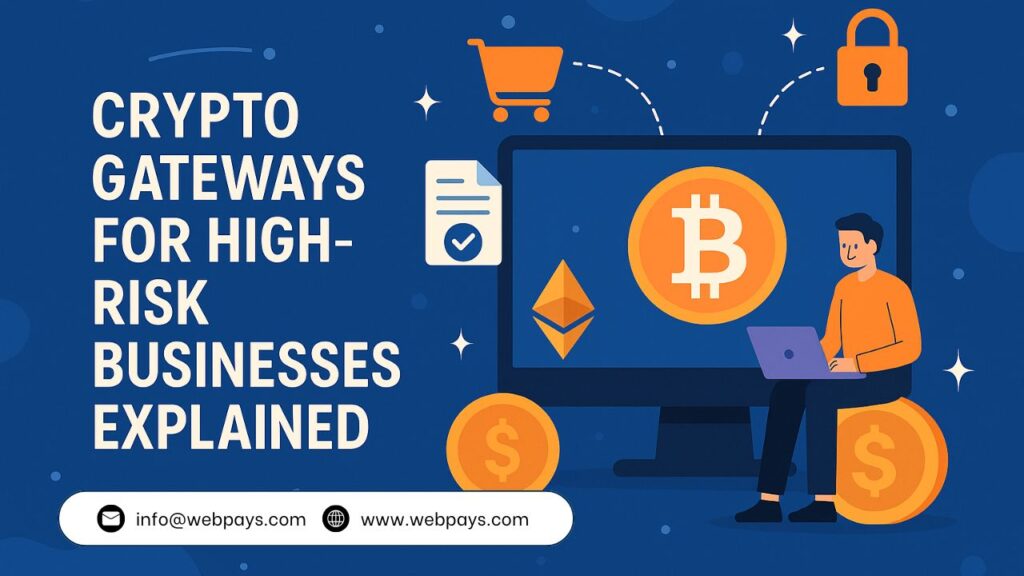
Cryptocurrency payments are no longer niche. They’ve become a practical option for businesses that face limitations with traditional banking and merchant services—especially those considered high-risk. Whether you’re operating in online gaming, adult services, nutraceuticals, or subscription models, the appeal of crypto is clear: fewer gatekeepers, faster settlement, and access to a wider pool of customers.
But does it really make sense for your high-risk business to adopt a crypto gateway?
Let’s break it down.
Why Crypto Appeals to High-Risk Businesses
High-risk industries often struggle with approvals from banks or payment processors. Accounts get frozen, chargebacks pile up, and compliance demands grow heavier by the year. In this environment, crypto offers a way out—not as a replacement for traditional payments, but as a parallel option that adds flexibility.
Since cryptocurrencies like Bitcoin, Ethereum, and stablecoins don’t involve credit card networks, businesses bypass a lot of the red tape. Transactions settle faster, international payments are easier, and there’s no risk of traditional chargebacks.
Still, it’s not just about moving funds. A crypto-friendly payment gateway gives businesses structure. It connects wallets, facilitates conversions to fiat, provides customer interfaces, and plugs into your checkout system—just like any other gateway, but built for digital assets.
Features to Look for in a Crypto Gateway
Not all crypto gateways are built for high-risk needs. Some are designed for simple, low-volume transactions. Others don’t support the kind of compliance standards or currency conversions that high-risk merchants depend on.
Here’s what to prioritize:
- Volatility Protection: Crypto prices shift fast. Good gateways auto-convert crypto to fiat on the spot to avoid losses.
- Multiple Coin Support: Accepting Bitcoin alone isn’t enough. Look for support for Ethereum, USDT, and other popular options.
- Fast Settlement: Delayed payouts defeat the purpose. A proper system settles funds quickly and reliably.
- Integration Options: Whether you run an eCommerce platform or a custom-built site, integration should be flexible and developer-friendly.
- Compliance Support: Especially important for high-risk sectors. Look for providers that manage KYC, AML, and regulatory obligations.
If your current provider doesn’t offer these features, it may be time to evaluate a high-risk-focused gateway. This page outlines how certain processors build around high-risk operations.
Common Concerns and Misconceptions
One hesitation many merchants have is the volatility of crypto. But with stablecoins pegged to fiat currencies and auto-conversion tools in place, that risk can be managed easily.
Another concern is whether customers will actually pay with crypto. Adoption is growing, particularly in industries where users value privacy and anonymity. For some platforms, crypto makes up a significant share of monthly volume.
Security is also a major talking point. A good crypto gateway isn’t just about accepting coins—it also helps detect suspicious activity and limits your exposure to fraud. While chargebacks don’t work the same way as cards, disputes can still happen. That’s why it’s important to partner with a provider that understands the high-risk space.
Crypto and Traditional Gateways Can Coexist
One of the smartest moves is not to switch completely to crypto, but to offer it alongside cards, e-wallets, and bank transfers. Let the customer choose. This not only increases your conversion rate but also gives you more control over how you receive and manage your revenue.
Combining traditional options with crypto-ready payment solutions gives your business more resilience. You’re less dependent on one system, and you’re better prepared if one channel slows down or faces regulatory pressure.
Is It Worth It?
For high-risk businesses, crypto gateways aren’t a trend—they’re a backup plan, a global access tool, and in some cases, the only working solution available. But just like with traditional processing, it all depends on the provider. Some are built for scale, others are not.
If you’re already facing friction with banks, getting shut down by processors, or just looking to expand your options, crypto could be the right step. But the value only comes when the system is set up correctly—with support, compliance, and stability in place.
Need help figuring out which direction to go? Reach out here and get expert input based on your industry, volume, and goals.
Also Read: High-Risk Payment Processing – A deeper dive into payment options when banks say no.
